Narrative Anxiety
By Mark Rickerby
In 2009, while living in Berlin, I started writing a novel about a civil war in New Zealand. It’s still not finished, but writing and designing it has been a remarkable experience that has changed my life.
You might think that working on a project for five or six years without releasing anything more than a fragmented manuscript to a very small, select audience, sounds a lot like failure. You’re probably right. I’m circumspect about this. Many times, I’ve been close to giving up, rage-quitting, deleting the entire project and moving on. The fact that I haven’t still amazes me.
Creativity never works out quite the way you plan or expect. I’d always envisaged writing a linear novel but I was frustrated and blocked for several years trying to piece it all together. It wasn’t until I reimagined the work as interactive that it finally started to make sense.
I want to try to explain the process by which this happened, and discuss some of the deeper lessons I’ve learned. Lessons that will hopefully be relevant to anyone interested in telling stories across different forms of media.
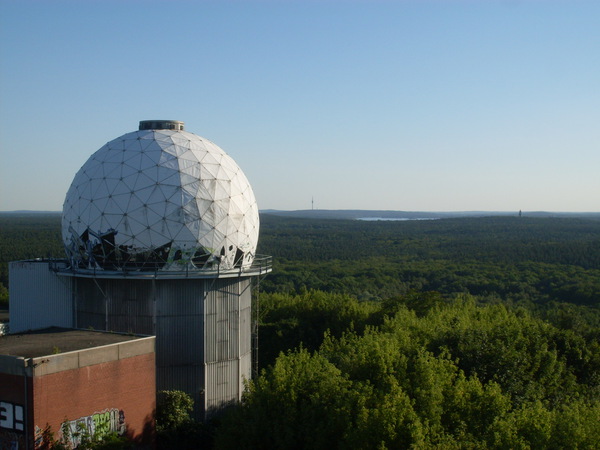
This is a photograph I took in summer 2010, standing atop the ruins of the NSA listening station on Teufelsberg. It’s a good representation of the ideas and obsessions that were feeding into my writing then—surveillance, signals intelligence, deep politics, and the lingering ghosts of the cold war.
At the time, Berlin was going through its post-gentrification, pre-startupification, ‘poor but sexy’ phase. The city seemed to be brimming with hackers, artists, musicians, activists, intellectuals and freaks from all over the world. The Berlin Piratenpartei had recently won nearly 4% of the vote at the German federal election and were setting their sights even higher. Wikileaks was not yet mainstream but its public profile was rapidly growing, thanks to the release of the Collateral Murder video in early 2010.
With these influences around, it might seem strange that I ended up writing so much about New Zealand. It mostly happened by accident, starting out as just a very small part of all the other things I was researching and exploring.
As I slowly uncovered more and more information about the UKUSA agreement, Australia’s secret space programs, and New Zealand’s long-term involvement in the 5 Eyes alliance, my writing started going off on various speculative tangents about the looming presence of oil companies and the National Government’s obvious interest in offshore drilling that nobody in New Zealand seemed to be talking about at the time.
Eventually, I saw the shape of a book in all of this.
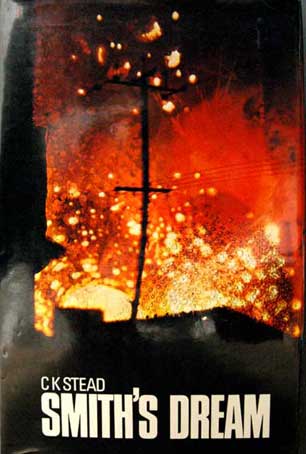
This is Smith’s Dream by C. K. Stead. It’s a novel from the early 1970s about an authoritarian dictator seizing control of New Zealand, backed by covert military support from the United States. It’s not about high politics. It’s written from the perspective of ordinary people, caught between the police state and the underground revolutionary movement. A cult classic in New Zealand, but little known elsewhere.
My friends often used to joke that I should write a remake of Smith’s Dream. I didn’t really plan things out that way, but it’s the most obvious major influence.
The plot of Godzone emerged after I became intensely interested in the question of how much damage a small, well-funded group of ideologically motivated campaign consultants and corporate lobbyists could do if they focused their energies and talents towards engineering a takeover of the Government.
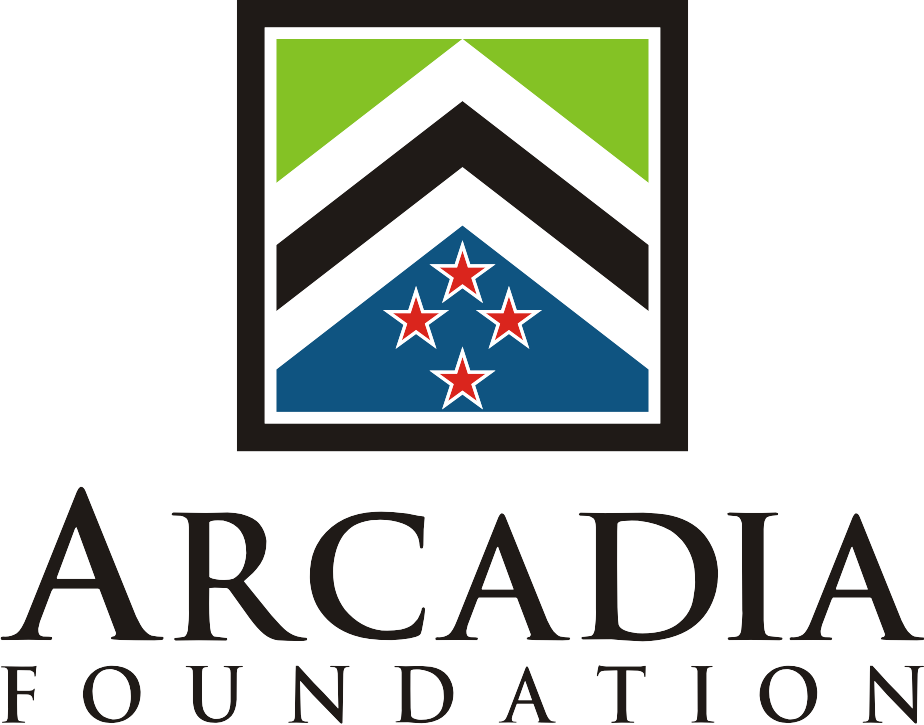
This is the logo of the Arcadia Foundation, a fictional entity in the story. The Arcadia Foundation is a radical libertarian think tank and nascent political party. Their agenda is to seize control of the South Island and turn it into an independent state, opening the door for massive profits from offshore oil drilling.
In an early draft of the story, one of the most severe consequences of the Arcadia Foundation’s wanton political manipulation was a civil war and the subsequent destruction of Christchurch. So I was writing about all of this, getting deeper and deeper into the idea of a ‘rebuild’ as a pretext for seizing control of the city.
And then this happened:
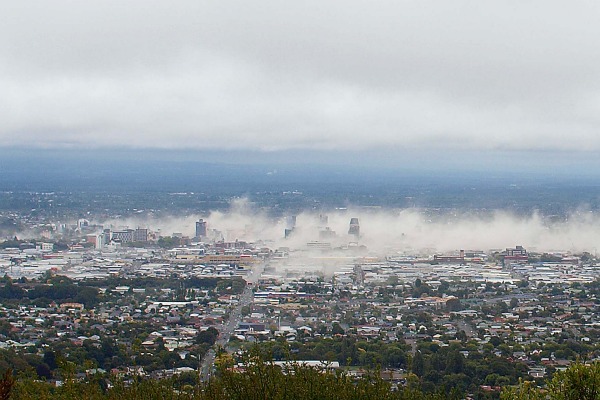
It took me more than a year to start writing again.
The story turned towards hacktivism, spying and subterfuge. I rewrote large chunks of the original past tense narrative in the present tense, which had the effect of focusing time in the moment, reinforcing the anxiety and paranoia of the lead characters.
Moving away from the idea of a civil war, I started developing new threads of the story touching on activism, protest groups, Tino Rangatiratanga and illegal state surveillance.
And then Edward Snowden came along.
These revelations blew the whole basis of the story wide open, forcing me to go back and rewrite a lot of material that no longer made sense in this strange new world where the general public had become aware of ubiquitous mass surveillance being a fact rather than fiction.
Emerging novelists are generally cautioned against writing about contemporary society directly. I used to think that this was because everyone with a literary ego loves the idea of creating a book that’s ‘timeless’. Seeing your work go out of date or become thematically irrelevant seems a lot worse than selling badly or being inauthentic. I wanted to challenge and subvert this expectation, but I learned the hard way that such advice exists for a very good reason.
Present day reality will always be wilder than fiction
One of my big ideas about novels is that they enable a kind of formal experimentation with structure that isn’t possible in any other medium. Rather than seeing this as ‘nice to have’—something we say all the time in the software industry to describe good ideas that might be inessential to a finished product—I saw formal experimentation as an imperative. Something I must do.
The structure I developed was based on the concept of interleaving and folding two separate books into one. The narrative moved between a first-person past tense memoir written by an activist whose suicide initiates the main events of the story, and third-person free indirect chapters in the present tense that wrapped around the memoir.
This might have worked better if I’d scaled back the world building and character exploration and focused more on planning a tightly structured plot. Instead, I went in the opposite direction.
I was fulfilling every cliché of a first novel. By 2013, I had accumulated 120,000 words of prose from the perspective of eight viewpoint characters as well as a sprawling mass of supporting material, including emails between characters, news reports, diplomatic cables, fake Wikipedia pages, and transcripts of television and radio shows.
I knew that in order to produce a readable book out of this material, I’d have to throw a lot of it out and potentially change the structure, but so many of the characters and events were interdependent that changing something in one place would quickly ripple out to cause changes in other places.
For a long time, I tried to resolve these tensions by morphing the abstract organisation of chapters and sections into various shapes.
What I really wanted—for both aesthetic and thematic reasons—was a spiral-shaped narrative, but I couldn’t figure out how to make it work with the characters and plot elements that I knew I wanted to keep.
I imagined a beautiful interlocking octagonal narrative structure that looked something like this:
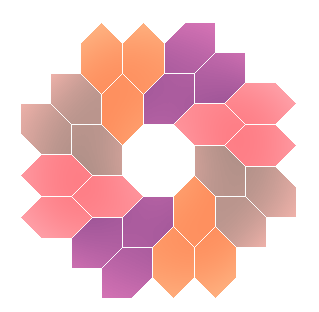
But the resulting manuscript was patchy and uneven, with a structure that looked more like this:
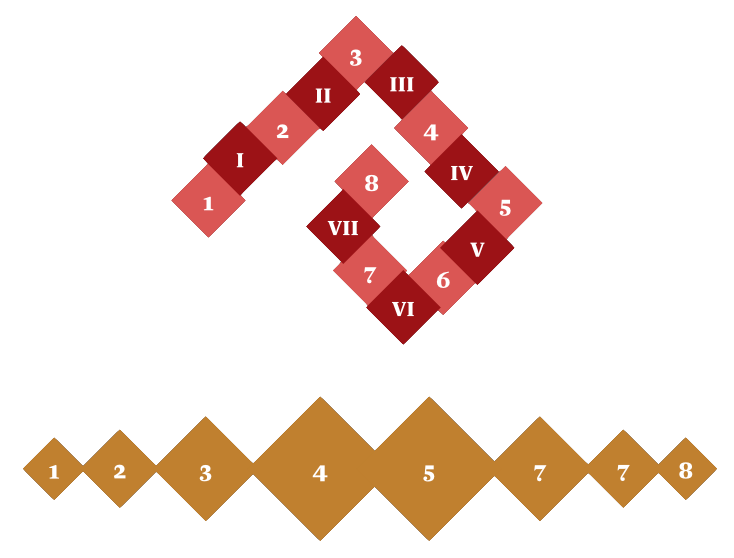
Or maybe it was shaped like an octopus?
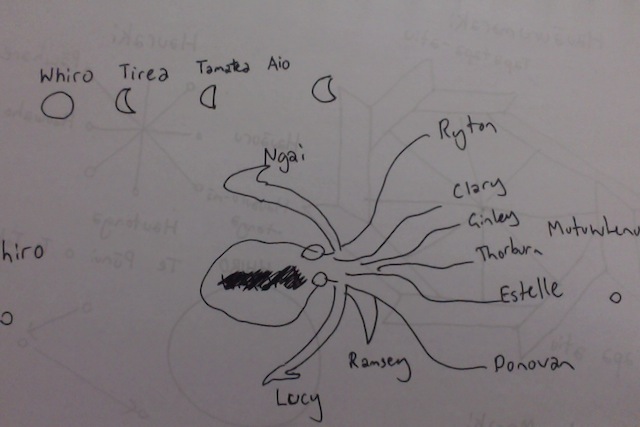
When I first started writing, having abstract structural concepts to work from was really helpful. I wouldn’t have developed the characters I did, nor written such a large volume of text without having a well formed skeleton to flesh out and paint by numbers.
But eventually, the story started to spill out in directions beyond my control. Trying to have all the chapters and character arcs conform to an elegant formal structure became constrictive and arbitrary. It was getting in the way of the plot and making the story far too abstract and incoherent.
I had to ask myself who I was writing for. And why?
It’s okay to treat formal structure as scaffolding rather than art
In hindsight, this structural exploration seems like a pattern of avoidant behaviour as much as a creative strategy. Maybe these tangents of thinking reflected my anxiety about unsolved problems with the story itself. Problems that could only be resolved by making firm choices about character conflicts and resolution of the plot.
There were multiple possible endings, and I was refusing to commit to a fixed outcome.
I realised I needed to take a completely different approach to what I was doing. I sent the manuscript to Marissa van Uden—a brilliant editor in Berlin who specialises in speculative fiction and story development—and forced myself to stop writing, tweaking and changing things.
It was then I started thinking.
As a graph data structure, the story actually made sense
This is a force directed graph of the actual story structure as it was in November 2014.
Each node in the graph is a text file containing anything from a few hundred to a few thousand words of prose. The core of the story is visible in the linked narratives of the four main characters that all spawn from the same inciting incident.
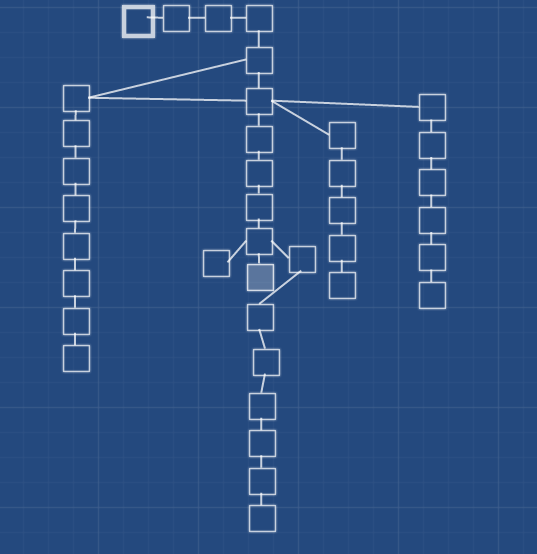
This is the initial prototype of the story graph that I extracted into Twine in December 2014. Being an almost direct transcription of the previous manuscript, it’s extremely linear, but you can see that almost immediately, the narrative started to spawn branches based on choices that were nascent in the original prose. From this point on, I started breaking down the larger, coarse grained nodes into smaller, self-contained scenes linked by character choices.
Both representations of the story here show a lot of garbage that I’ve subsequently reshaped or culled.
I guess the idea of representing the story as a network graph had been swirling around in my head for some time, but it didn’t come together until I took a break from writing and let the manuscript cool down for a bit.
I had gotten so obsessed with particular structural forms that I had cut myself off from my own style of creativity and my motivation for working on this in the first place.
Once I started thinking about the narrative on this level, I realised that there was no way I could go back to my previous vision of a linear novel. It wasn’t a flash of inspiration or a sudden leap of discovery. It was a slow, gradual, growing understanding.
Let the story shape the form of its container
As a consequence of this change in direction, I’ve been thinking a lot about the blurred boundary between stories and games.
Interactive fiction has a rich and fascinating history and its influence on storytelling in modern games is fairly well documented. The origins of interactive fiction are closely linked to the 1970s RPG trope of the ‘dungeon crawl’, emphasising spatial movement through the branches of the story. The Infocom games of the 1980s—like Planetfall, The Hitchhiker's Guide to the Galaxy, and A Mind Forever Voyaging—transcended this emphasis on exploration and adventure to achieve a new level of comedy and expressive narrative in games.
What we hear about interactive fiction today is almost always about the influence of text-based adventures on the modern games industry. It’s easy to forget there was another style of fiction in the 1980s and 1990s that introduced millions of kids to interactive storytelling through reading books:
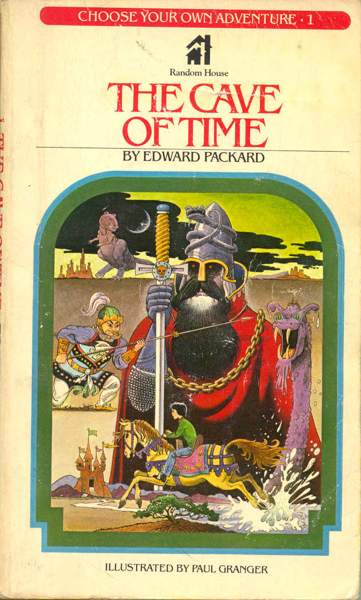
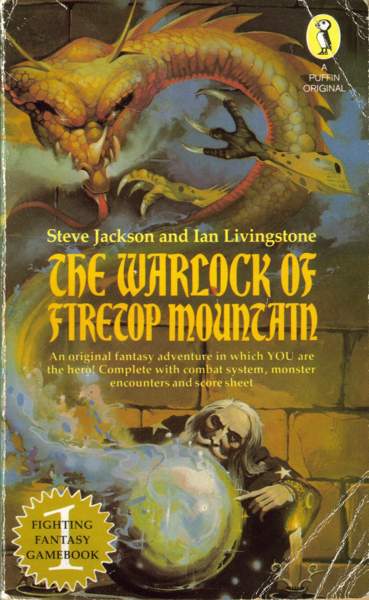
Even within this relatively narrow sub-genre of print publishing, there’s a huge diversity of different narrative structures, approaches to state tracking, and meta-narratives involving infinite loops and unreachable passages based on quirks that only make sense on the printed page.
For the past two decades, this style of storytelling has been set somewhat apart from the mainstream of English literature as well as videogames. Interactive fiction is often overlooked as a genuine literary genre. At the same time, the mainstream Western gaming audience treats interactive fiction with derision, judging many of these works as ‘not real games’.
Thankfully, this is starting to change. One of the most popular and critically acclaimed iOS titles of 2014 was a text-based adventure with surprising and innovative differences from traditional text-based user interfaces. The success of 80 Days shows that quality writing can be the primary driving force of a game narrative, and that this can work successfully by itself without needing to be hitched to the wagon train of sprawling, immersive AAA interactivity.
I don’t want to wade in to the whole ‘narratology versus ludology’ debate, or go off on a tangent about the conflict over formalism or systems versus representation, except to say that there is a complex relationship between different kinds of media, affordances, and the narratives and fictions that these convey. Some things are medium-specific; some things aren’t.
What interests me more is that there’s a vast constellation of media that exists in the blurred region of intersection between games and novels. A strong indicator of the non-status of these works is the difficulty we still have in labelling and describing them.
Are we talking about ergodic literature, transmedia storytelling, interactive fiction, visual novels, hypertext novels, choicefic, or gamebooks?
I’m not sure which of these categories my work fits into and I didn’t think it mattered until I started running into situations while building the app where these distinctions actually became something emergent in practice.
An example of one of these situations is the choice of whether to call the user model Reader or Player. On the surface, this is an arbitrary semantic decision, but it actually influences a wide range of things in the code—everything from server-side session handling to the structure of UI components—as well as touching on deeper questions about the scope of interactivity and my attitude towards the audience.
At the back of my mind were two related questions. How far could I take these ideas before my work becomes unrecognisable as a novel? And what would a hypermedia novel look like?
A hypermedia novel
Against my better judgement, I’m going to show a few in-progress screenshots so you can see concrete examples of what I’m talking about, rather than just handwavy gestures and suggestions.
Everything here is running in a web browser. Some of these views are already being fed with real data from the backend, while others are static user interface mockups.
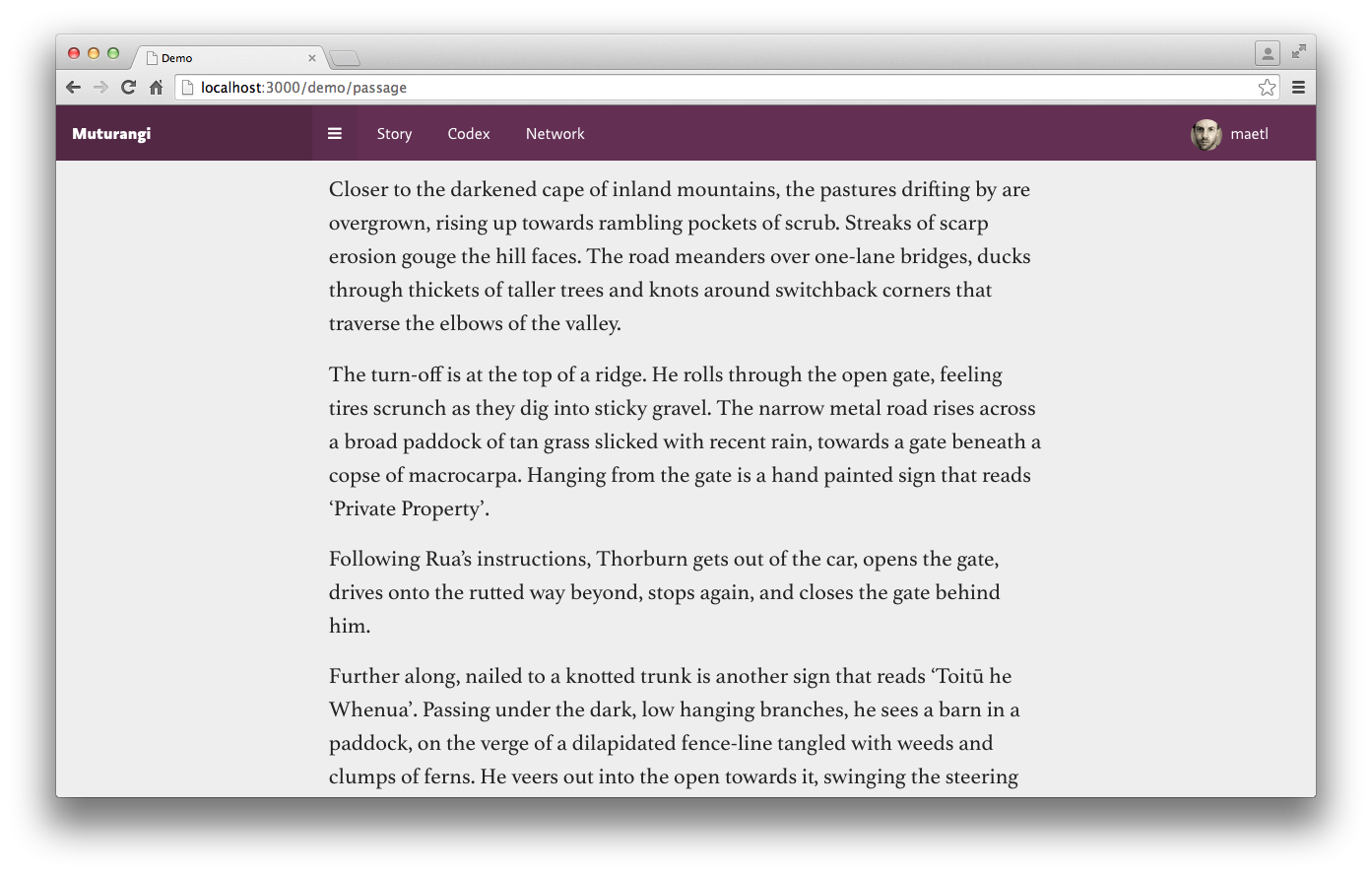
The standard presentation of the story text highlights the fact that this is still mostly a linear narrative, told in a traditional way.
The character choices are also fairly traditional, but do raise some interesting questions about temporality, state handling and back-tracking.
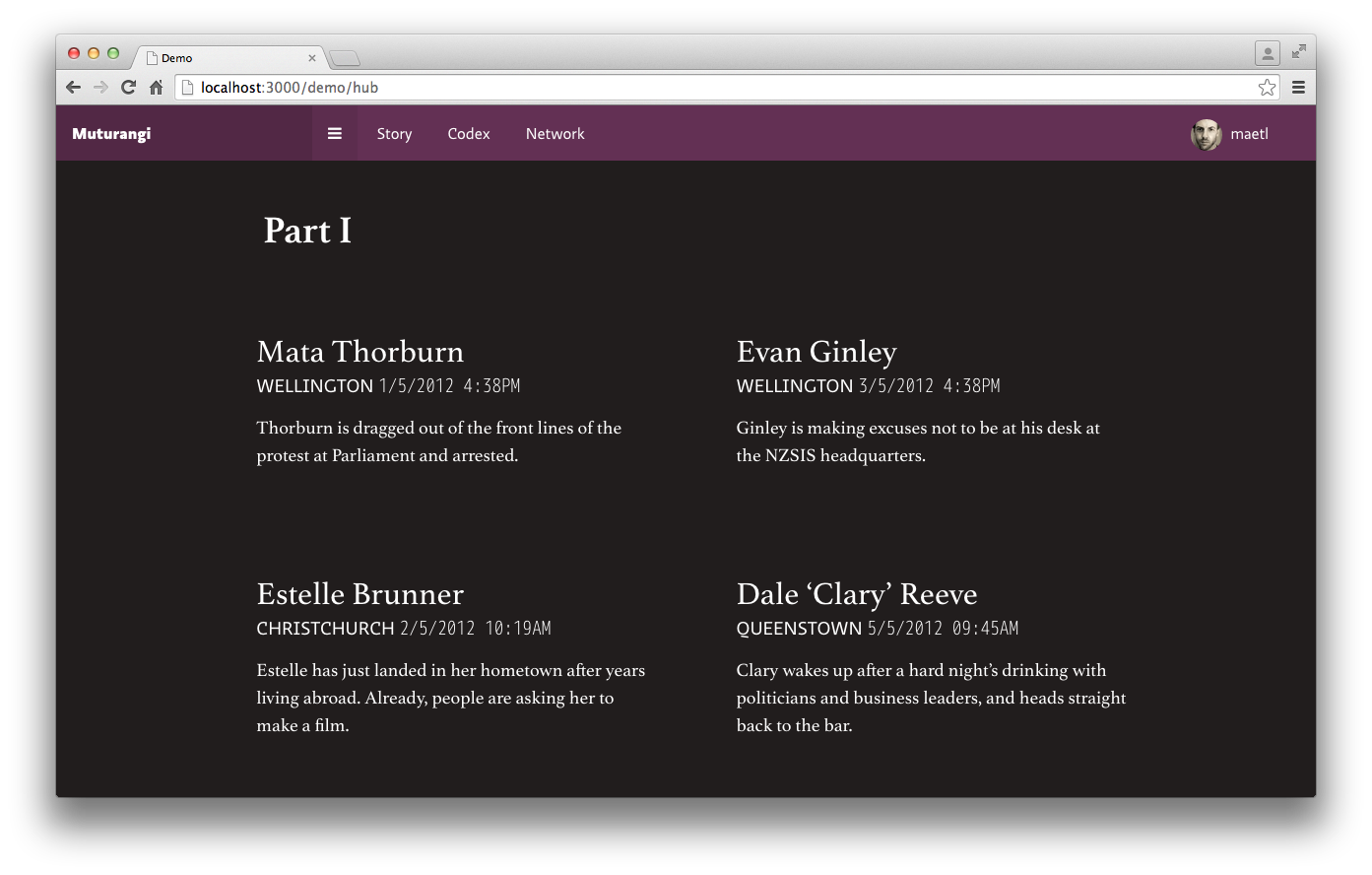
My original concept for presenting emails, texts and news articles was to mix them in with the main prose narrative, influenced by the structure of various epic novels that I was obsessed with—like Stand on Zanzibar and The Golden Notebook.
One of the problems I found with this approach in editing, was that it very often ended up being little more than a structured form of infodumping. It was boring to read.
Embedding the content in a graph data structure helped me to see new possibilities for presenting media articles, vignettes and fragments in a way that was actually relevant to the story.
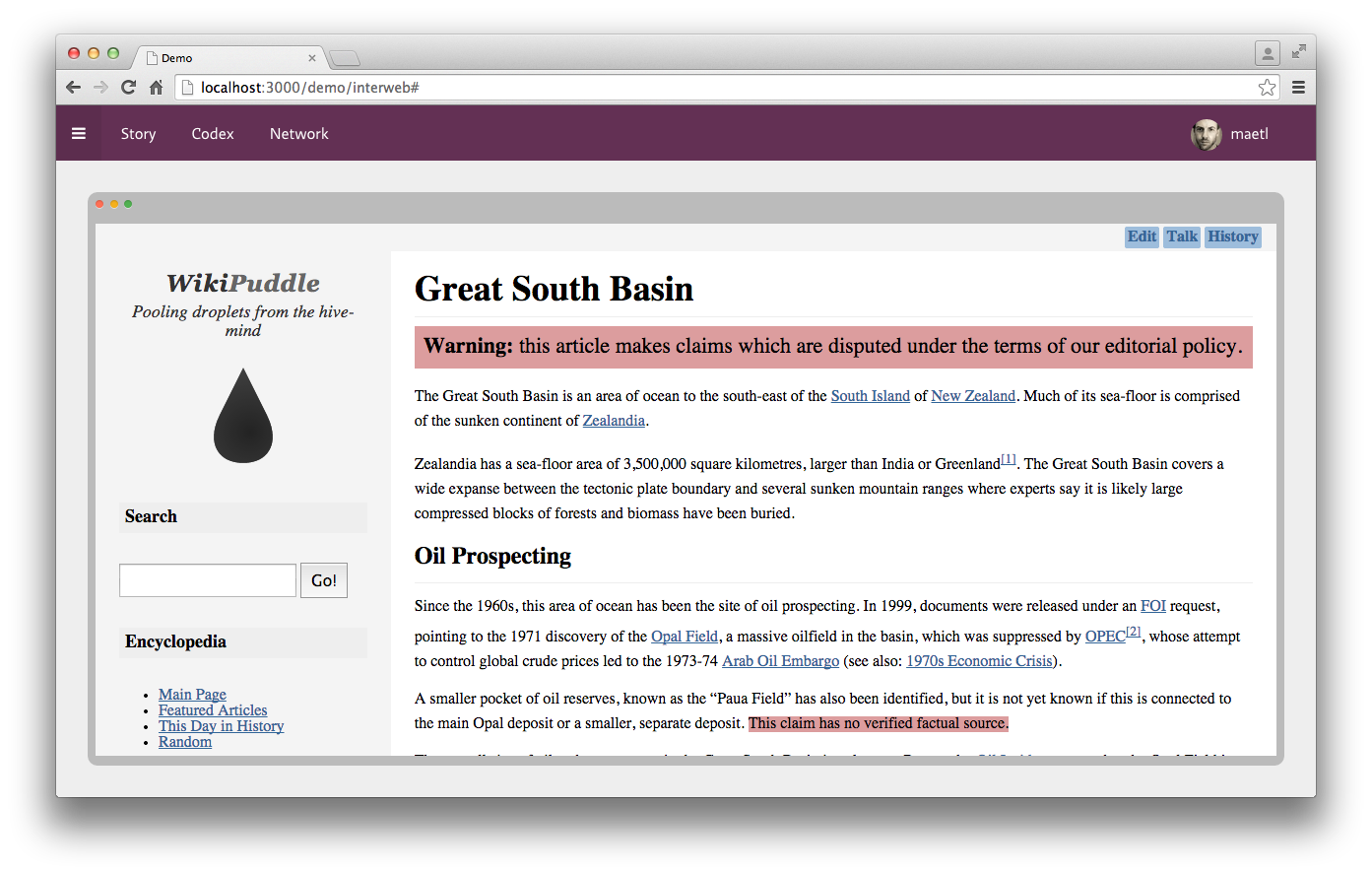
The zeitgeist of today’s reading experience is the web browser with twenty tabs open; the Wikipedia rabbit hole; the clickbait journey into hell; the spiraling infernal passages into the dark underbelly of internet culture on forums like Reddit and image boards like 4chan.
I started thinking about this aesthetically, and came up with the idea of modelling the presentation of story elements around each character’s experience of the world through the internet.
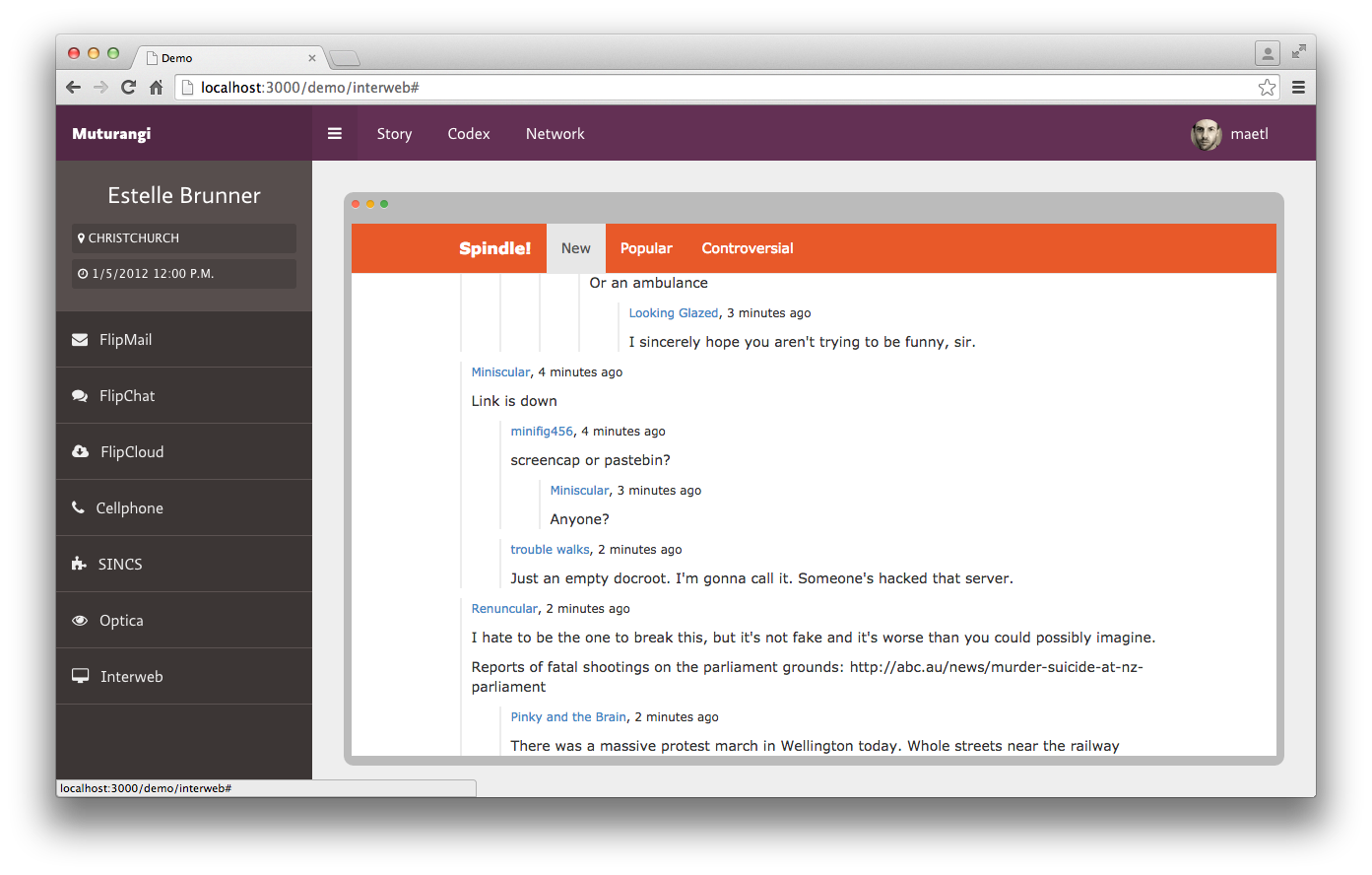
Maybe readers could skim the email inbox of a character and look at their browser history. Or use surveillance tools to spy on other characters.
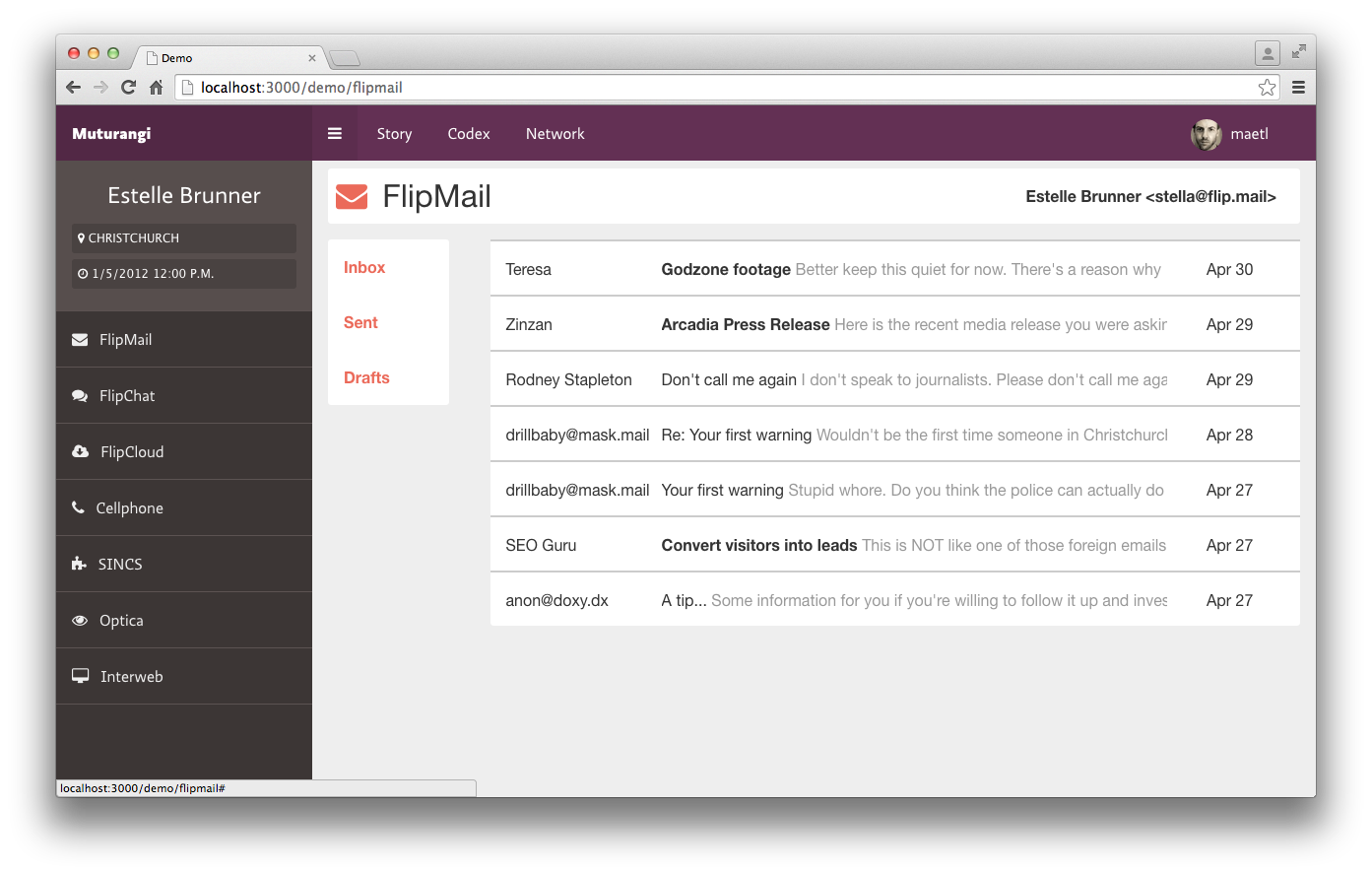
This actually leads to some fairly extreme possibilities for stalking the readers as they move through the story. It could be taken so far as to let readers themselves spy on other readers.
From my perspective, this is something that resonates with the core themes of the story but is potentially problematic. I’m not sure how far I want to go with it, and I’m not sure how acceptable readers will find it.
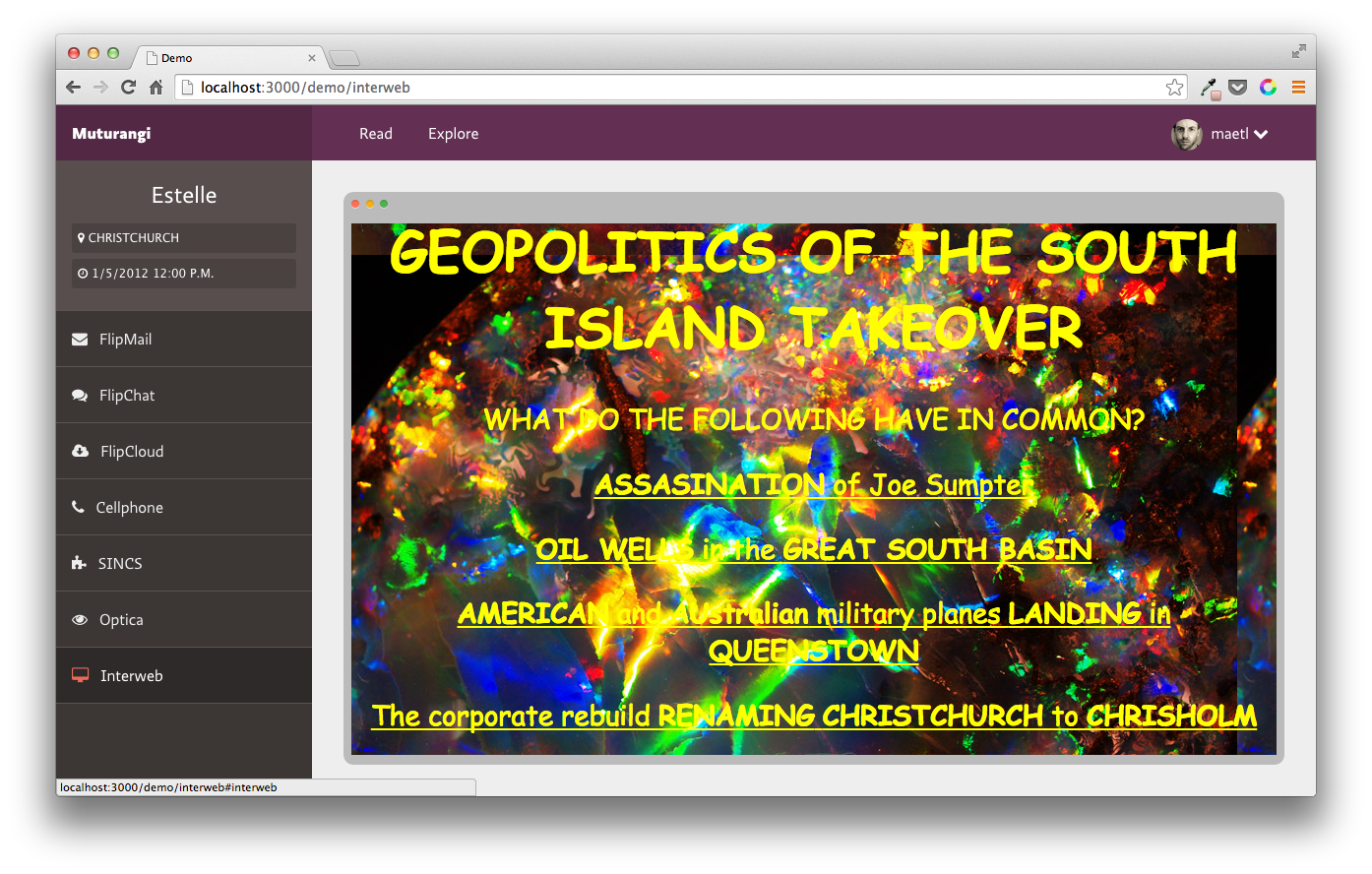
Something I probably need to touch on at this point is the increasing scope and complexity of the project. Although making the story interactive has helped me to deal with the original manuscript in a much more satisfactory way, these new ideas require a lot more text, and threaten to take up a lot more time.
So over the summer, as well as building this app, I’ve been building tools for procedurally generating large volumes of world-building text, using both recursive transition networks and Markov chains. The results have been hilariously entertaining, and I think they’ll provide an interesting layer of verbiage in what is fast becoming a satirical parody of XKeyscore.
Putting all these elements together, I want to explain how I see the work fitting together as a system. Although I still think of it as a novel, at this point I couldn’t care less whether people approach it as a game, a book, or an experimental agglomeration of e-waste.

There are three major forces shaping the presentation of the story. The prose manuscript and procedurally generated content are relatively easy to understand—they’re just pieces of text relating to a character or a fake media publication. The third force—that of the readers themselves interacting with the story—is something I haven’t explained in a lot of detail, because I’m still not really sure how to manage it.
The ‘text’ itself is a graph database, with a structure of nodes representing each piece of text joined by links based on choices or connections in the story. The nice thing about this is that the story can be treated as a continuous structure, irrespective of time, linear order, or categorisation of different types of content.
In a traditional database, all these different kinds of content would be structurally separate. But with a graph database, everything is part of the same global web of objects. Recording the activity of readers in the same database means that their actions can be absorbed into the narrative structure itself.
Playing with surveillance is just one of many possibilities.
As I touched on earlier, the thing that’s been hardest to deal with in deciding to make this story interactive is the realisation that this is going to take many more months of effort to properly finish. It’s no longer just writing and editing, but also software development, UI design, graphic design, systems administration, and a bunch of other things that I haven’t fully understood because I haven’t had to deal with them yet.
It probably seems ridiculous. But if you were in my position, given my background, my skills and experience, why wouldn’t you?
Don’t be afraid of projects that take 5–10 years to complete
We don’t often talk about it, but there’s something to be said for artists and creative people committing to these large, messy, long term projects that take up an entire phase of their career.
Sometimes people do this on purpose, and are conscious of how long it’s going to take. But then sometimes it happens by accident, and only makes sense in hindsight.
What’s been especially hard for me is the cognitive dissonance that comes from having worked in the software industry for so long. The values of startup tech culture are completely antithetical to what I’m suggesting here. The catch-cries of ‘just ship it’ and ‘move fast and break things’ can sometimes be powerful and motivating advice, but it’s an attitude that’s ultimately toxic and destructive towards long-term endurance and sustainable creativity.
This leads me what has probably been the most difficult and humbling lesson of all.
Art is difficult. Doing what you love rather than what pays the bills is difficult. Doing something that you’ve never done before that makes utterly no sense at first is difficult.
There’s a loneliness that comes with that difficulty. You become so focused and obsessed that you start to isolate yourself, and I don’t think there’s anything wrong with that per se. The problems arise when your belief systems about your creative identity and ideal state of mind come into conflict with your health and wellbeing.
I have struggled with bipolar and anxiety problems for years. Instead of seeing these flare-ups as harmful, I wore them as a badge of honour. For a long time, I thought that in order to do my best work, I had to be pushing myself to the limit mentally, emotionally and sometimes even physically. My manic states were something I tried to channel into my work, rather than learn how to manage and cope with as a matter of surival. The long-term conseqence of all this was debilitating episodic depression and breakdowns.
Destroy the mythology surrounding ‘lone writers’ and ‘tortured artists’
There is a lot of social pressure to support this mythology. I believe it leads to unnecessary pain and unhealthy attitudes towards learning and creativity. It justifies people being rude and behaving like assholes. It encourages people to hide away, working on their own, instead of reaching out and collaborating. It almost never leads to better art being made.
I first had to consciously accept that I could change my beliefs about the relationship between mental illness and creativity before I could change my patterns of behaviour.
As creative people—writers, artists, storytellers, designers, programmers—we want to feel that our work really matters. We want to know that what we’re doing is powerfully connected to an expression of our self-identity. That it’s important and essential.
What’s actually helped me the most is embracing the opposite. Separating my ego from the work; accepting that not everything I write needs to be a deep expression of my identity; that I can do my best work without being in a fey state of magical, maniacal thinking; and detatching myself from perfectionist anxiety about failure and critical judgement.
Patience is something that I’ll always struggle with, but I am improving.
Of course, I’m terrified of how much work on this is still remaining, but overriding that is a sense of relief. After everything I’ve made and everything I’ve learned, I’ve finally come to the point where I don’t take myself or what I’m doing so seriously any more.
That in itself is an achivement I’m happy with.